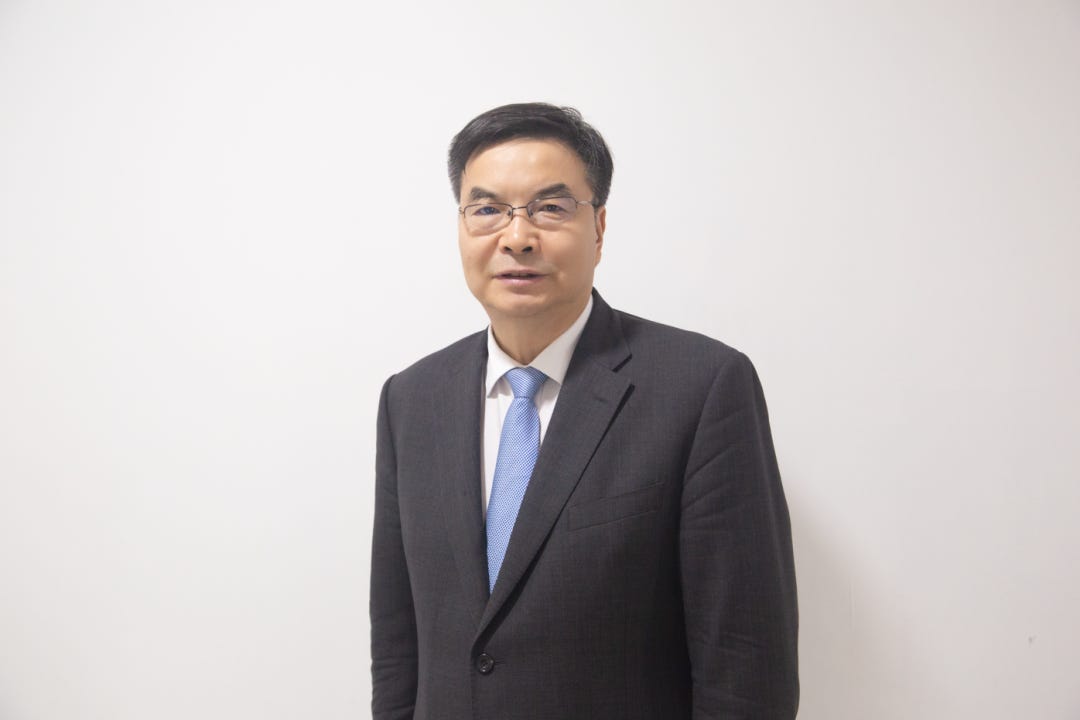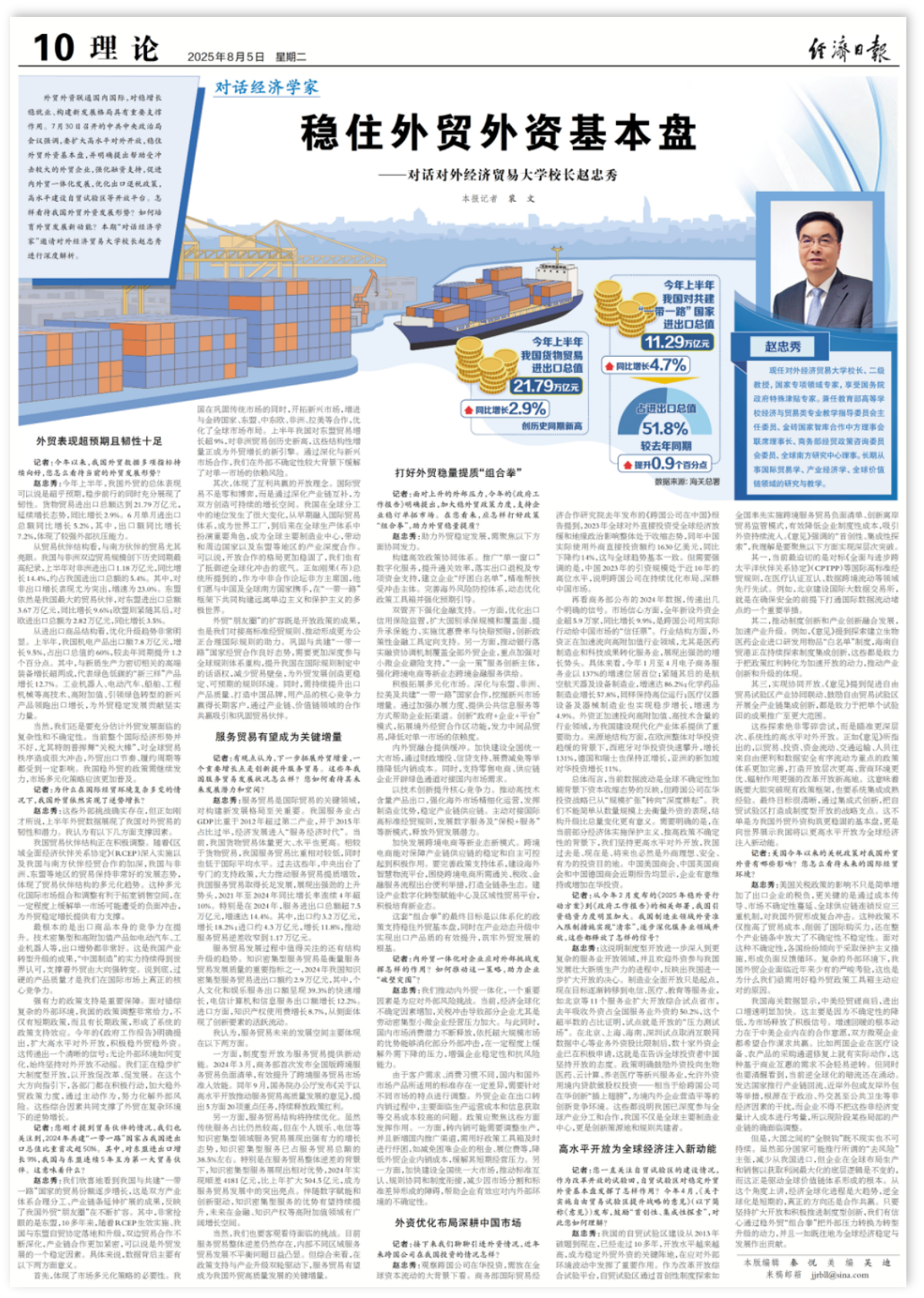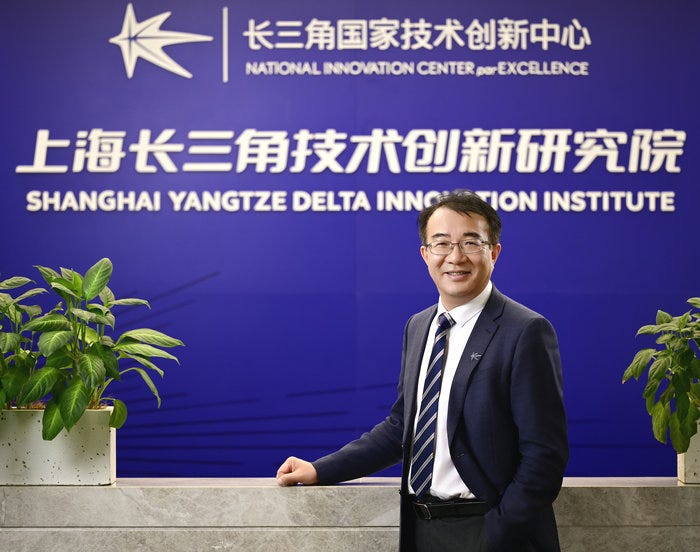(15th State Council Study Session) What Zhao Zhongxiu advises Beijing on foreign trade & investment
Interview with the president of the University of International Business & Economics, who just brief the State Council at its 15th study session
On August 26, Zhao Zhongxiu (赵忠秀), president of the University of International Business and Economics (UIBE) and a longtime scholar of international trade, industrial economics, and global value chains, was invited to brief the State Council at its 15th study session. The session focused on "accelerating innovation in trade in services and actively cultivating new drivers of foreign trade growth加快服务贸易创新发展,积极培育外贸发展新动能."
Beijing rarely releases full texts of guest lecturers' remarks. To glean Zhao's current thinking, this edition features a translated interview he gave to Economic Daily on August 5 about "stabilizing the fundamentals of foreign trade and foreign investment稳住外贸外资基本盘," a theme that closely mirrors the State Council discussion.
Economic Daily is an official Chinese news outlet. The translation below is mine and President Zhao has not reviewed it.
Also, the newsletter has been following the State Council's study sessions. If you're interested, here are two related editions:
#13: Top economists call for fairer income distribution, stronger support for lower-income groups
稳住外贸外资基本盘——对话对外经济贸易大学校长赵忠秀
Steadying the Fundamentals of Foreign Trade & Investment— A conversation with Zhao Zhongxiu, President of the University of International Business and Economics
External Trade: Outperforming Expectations with Notable Resilience
Interviewer: Since the start of this year, multiple indicators in China's foreign trade have continued to improve. How do you view the current foreign trade picture?
Zhao Zhongxiu: In the first half of this year, China's overall trade performance exceeded expectations. While advancing steadily, it also demonstrated strong resilience. Total goods trade reached RMB 21.79 trillion, extending its growth trend with a year-on-year increase of 2.9%. In June alone, total imports and exports rose 5.2% year-on-year, with exports up 7.2%, underscoring robust external stress resistance.
Looking at our trading partners, performance with Global South partners stands out. China's bilateral trade with Africa hit a record high for the period: imports and exports to Africa totaled RMB 1.18 trillion in the first half, up 14.4% year-on-year and accounting for about 5.4% of China's total trade. Exports to Africa were particularly strong, growing 23.0%. The ASEAN remained China's largest trading partner, with two-way trade at RMB 3.67 trillion, up 9.6%; the European Union followed at RMB 2.82 trillion, up 3.5%.
By product structure, the upgrade trend is clear. In the first half, exports of electromechanical products reached RMB 7.8 trillion, up 9.5%, constituting 60% of total exports, 1.2 percentage points higher than a year earlier. High-end equipment closely linked to "new-quality productive forces" grew by over 20%, and the green, low-carbon "New Trio (namely EVs, lithium-ion batteries, PV products)" rose 12.7%. Emerging products with high tech content and value-added, such as industrial robots, EVs, ships, construction machinery, led export growth and provided a solid anchor for trade stability.
Of course, we must fully appreciate the complexity and uncertainty ahead. The global economy is weak, and tariff moves by the Trump administration have significantly disrupted the trade order, affecting export pace and fulfillment cycles. China's policies to stabilize trade must continue to exert force, and market diversification should become even more widespread.
Interviewer: Why has China's foreign trade managed to grow against the headwinds in such a complex external environment?
Zhao Zhongxiu: External challenges are real, but as noted, first-half data reveal the resilience and potential of China's trade. Several factors are at work.
China's trade-partner mix is actively adjusting. With deeper implementation of the Regional Comprehensive Economic Partnership (RCEP) and closer ties with Global South partners, trade with Africa, the ASEAN, and others has maintained strong momentum, reflecting a diversified partner structure. This diversified market portfolio broadens sales space and cushions shocks from any single market, thus providing strong support for steady growth.
Most fundamentally, our export products are becoming more competitive. Technology-intensive, high value-added goods, like EVs and industrial robots, are growing rapidly. This stems from industrial upgrading: the strength of "Made in China" continues to gain global recognition, supporting the shift from a big trading nation to a strong one. Ultimately, solid product quality is the true core competitiveness in international markets.
Robust policy support also matters. Amid external complexity, China's policy response has been powerful and systematic, combining short- and long-term measures. This year's Government Work Report made clear that China will expand high-standard opening-up and actively stabilize trade and investment, which is a clear signal that opening-up is unwavering regardless of external changes. We are steadily broadening institutional opening, using opening-up to drive reform and development. Guided by this direction, ministries are stepping up measures to stabilize trade and proactively mitigating external risks. Together, these factors underpinned growth against the tide.
Interviewer: You just mentioned partners. In 2024, Belt and Road partner countries accounted for over 50% of China's total trade for the first time. Trade with the ASEAN grew 9%, and China and the ASEAN have been each other's largest trading partners for five consecutive years. What does this mean?
Zhao Zhongxiu: It is glad to see the rising share of trade with Belt and Road partners. This reflects rational division of labor and extended industrial chains, and shows China's "circle of friends" in trade keeps expanding. The ASEAN is particularly eye-catching. Over the past decade, with the entry into force of the RCEP and upgrades to the China–ASEAN FTA, bilateral cooperation has deepened and supply chains have become more intertwined—providing a stabilizer for trade. Two implications stand out behind the data.
First, it validates the necessity of market diversification. While consolidating traditional markets, China is cultivating emerging ones, enhancing cooperation with BRICS, the ASEAN , Central and Eastern Europe, Africa, and Latin America, to optimize the global market layout. In the first half, trade with the ASEAN grew over 9%, and trade with Africa hit a record high for the period. These structural increments are becoming new engines of growth. Deeper cooperation with emerging markets reduces reliance on any single destination amid external uncertainty.
Second, it reflects a win-win philosophy. Trade is not zero-sum; deepening complementary links along value chains creates sustainable growth space for both sides. China's role in global specialization has changed dramatically, from early integration as the world's factory to a central node in global production, spurring deeper industrial cooperation with neighbors and the ASEAN . The opening-up architecture is more solid, giving China greater confidence to withstand anti-globalization shocks. As the Republic of the Congo's president noted, as co-chair of the Forum on China–Africa Cooperation on the African side, they are ready to work with China and the Global South to build a multipolar world free from unilateralism and protectionism within the Belt and Road framework.
The expansion of China's trade "circle of friends" is both a result of opening-up and a contribution to aligning with high-standard rules and promoting fairer global rules. To consolidate momentum with Belt and Road partners, China needs to participate more deeply in rulemaking and improve its voice in setting international norms — reducing barriers and creating a more stable, predictable environment. At the same time, China needs to keep upgrading product quality and building Chinese brands — winning long-term clients with core product competitiveness — and anchor and grow partnerships through cooperation along industrial and value chains.
Services Trade: Poised to Be a Key Increment
Interviewer: Some argue that future trade growth will hinge on upgrading and innovating in services trade. How has China's services trade performed in recent years, and what is its potential?
Zhao Zhongxiu: Services trade is a critical pillar of international commerce and vital to building a new development paradigm. The services share of China's GDP surpassed that of secondary industry in 2012 and exceeded 50% in 2015, signaling entry into a "service economy." Currently, China's goods trade is larger and more advanced. Relative to goods, services trade still accounts for a smaller share in China and remains below the world average. Over recent years, the central government has rolled out targeted support to upgrade services trade quality and efficiency, and China has made great strides: from 2021 to 2024, year-on-year growth exceeded 10% for four straight years. In 2024, total services imports and exports topped RMB 7.5 trillion, up 14.4%. Exports were about RMB 3.2 trillion, up 18.2%; imports about RMB 4.3 trillion, up 11.8%, narrowing the services trade deficit to RMB 1.17 trillion.
Structural upgrading is also noteworthy. Knowledge-intensive services are a key indicator of quality. In 2024, China's knowledge-intensive services trade totaled roughly RMB 2.9 trillion. On the export side, personal, cultural and recreational services surged 39.3%, while telecommunications, computer and information services rose 12.2%. On the import side, charges for the use of intellectual property increased 8.7%, reflecting the active flow of innovation factors.
Looking ahead, two drivers stand out.
On the one hand, institutional opening will power services trade. In March 2024, the Ministry of Commerce released the first nationwide negative list for cross-border services trade, improving market access efficiency. In September, the State Council's General Office issued Opinions on Promoting High-Quality Development of Services Trade through High-Standard Opening-Up, proposing five dimensions and 20 key tasks to keep releasing policy dividends.
On the other hand, the structure of services trade will keep optimizing. While traditional services still weigh heavily, knowledge-intensive segments such as personal entertainment and telecoms show strong growth, accounting for around 38.5% of total services trade. Notably, despite an overall services deficit, knowledge-intensive services ran a surplus of RMB 418.1 billion in 2024, up RMB 50.45 billion from the previous year, a standout bright spot. With digital enablement and innovation-driven growth, these advantages should continue to strengthen, with broad room in high value-added fields like finance and intellectual property.
Challenges remain: the overall services deficit persists, and regional imbalances are more pronounced. But with policy support and industrial upgrading working in tandem, services trade is well placed to become a key increment in China's high-quality trade development.
A Policy Package to Stabilize Scale and Upgrade Quality
Interviewer: Facing rising external pressure, this year's Government Work Report called for stronger measures to stabilize trade and help firms secure orders and expand markets. In your view, what policy package will steady foreign trade volumes and improve quality?
Zhao Zhongxiu: Several fronts need to work in concert.
Build an efficient policy-coordination system. Scale up "single-window" digital services to speed customs clearance; implement export tax rebates and dedicated funds; set up "relief whitelists" to precisely assist impacted firms. Improve overseas risk-prevention systems, dynamically optimize policy toolkits, and strengthen guidance to anchor expectations.
Reinforce financial support on two tracks. First, refine regulation of export credit insurance — expand country coverage and capacity, apply preferential rates and expedited payouts, and innovate policy-finance tools for targeted support. Second, have banks extend financing-coordination mechanisms to all trade firms, with a focus on risk-hedging for micro and small enterprises; provide "one-firm-one-policy" services for innovators; and enhance cross-border financial services for new formats such as cross-border e-commerce.
Expand diversified markets. Deepen cooperation with the ASEAN , Africa, Latin America, and Belt and Road partners to tap new demand. Help firms build channels through stronger trade-fair support and public information services. Innovate "government + enterprise + platform" models, upgrade overseas economic and trade cooperation zones, boost trade in intermediates, and reduce dependence on single markets.
Use domestic–foreign market integration as a buffer. Accelerate the building of a unified national market; cut domestic-sales costs via fiscal inputs, credit support, and fee reductions for exhibitions. Facilitate green channels linking retail e-commerce and supply-chain firms to domestic demand.
Lift core competitiveness through technological innovation. Promote exports of high-tech products, hone market operations overseas, leverage manufacturing strengths, and stabilize supply chains. Proactively align with high-standard global rules, develop digital services and models like "bonded + services," and unlock trade potential.
Accelerate new business formats such as cross-border e-commerce. Cross-border e-commerce helps keep supply chains stable and controllable. Improve supporting policies, build smart overseas logistics platforms, and streamline customs, taxation, and financial services to support the full ecosystem. Establish digital-transformation enablement centers and regional trade platforms to nurture new business models.
The ultimate goal is to steady the fundamentals with a system-wide policy framework while achieving substantive quality upgrades in exports, consolidating the foundations of foreign trade development.
Interviewer: How does integrating domestic and foreign markets help firms weather external shocks? How should this strategy be advanced to help companies "break through the wall"?
Zhao Zhongxiu: One major reason to promote integration of domestic and foreign trade is to cope with external risks. With greater uncertainty in globalization and tariff-driven shocks, many firms, especially labor-intensive micro and small enterprises, face pressure. At the same time, China's vast domestic market continues to unleash consumption potential. Drawing on the advantages of scale can absorb part of the external shock, easing pressure from weaker external demand and strengthening firms' stability and resilience.
Because customer needs and habits differ, domestic and overseas standards can diverge, requiring product adjustments. When exporters pivot to domestic sales, they mainly face higher operating and information costs. Policy should target these pain points.
On one side, shifting to domestic markets may entail production changes and new promotion channels; we should use the policy toolbox for timely relief, such as rent and booth-fee reductions, to cut domestic-sales costs and ease short-term strain. On the other, we must accelerate the unified national market, promote mutual recognition of standards, regulatory coordination, and institutional alignment, reducing barriers from market segmentation and standard gaps, and helping firms manage uncertainty at home and abroad.
Foreign Investment: Optimizing Layouts and Deepening in China
Interviewer: Turning to foreign investment, how have multinationals been investing in China in recent years?
Zhao Zhongxiu: Assessing multinationals' investment in China requires a global lens. According to a report by the Chinese Academy of International Trade and Economic Cooperation under the Ministry of Commerce, global outward FDI contracted in 2023 amid slower growth and geopolitics. China's actual utilized FDI that year was about USD 163 billion, down roughly 14% year-on-year, broadly in line with global trends. Importantly, the 2023 level was high relative to the past decade, indicating that multinationals are optimizing their layouts and deepening in China.
Data released for 2024 send several clear signals. On market confidence, over 59,000 new foreign-invested firms were established nationwide, up 9.9%, a tangible "vote of confidence." By sector, FDI is accelerating into higher value-added areas — especially pharmaceuticals and services for commercializing scientific and technological achievements — with strong momentum.
From January to April, e-commerce services led with 137% growth; aerospace and equipment manufacturing followed at 86.2%; chemical pharmaceuticals grew 57.8%; and medical instruments and devices rose 4.9%. In short, FDI is flowing faster into high-value, high-tech sectors, bolstering China's push to build a modern industrial system. By source, while overall European investment slowed, Spain surged 131%, and Germany and Switzerland remained positive; from Asia, Singapore was up 11%.
Overall, the fluctuations reflect a global contraction under heightened uncertainty. Multinationals' China strategies are shifting from "scale expansion" to "deep cultivation." We shouldn't judge FDI solely by aggregates; upgrading the structure matters more. Despite protectionism and policy uncertainty elsewhere, China is committed to higher-level opening-up. China was, is, and will be an ideal, secure, and enabling destination for foreign investors. Recent reports by the American, British, and German chambers in China show many companies intend to maintain or increase their China investment.
Interviewer: From the February release of the 2025 Action Plan to Stabilize Foreign Investment to the Government Work Report's measures, China has clearly stepped up efforts. With manufacturing access restrictions now "zeroed out" and opening in services deepening, what signals does this send?
Zhao Zhongxiu: It means institutional opening has moved further into the more complex realm of services, and that China welcomes foreign participation in the growth of "new-quality productive forces." Full opening in manufacturing is only a starting point; the focus is shifting to services such as telecoms, healthcare, and education. In the 11 comprehensive pilot areas for expanded services-sector opening, foreign investment accounted for 50.2% of national services FDI last year.
This majority share shows pilots are "stress-testing grounds" for opening. After Beijing, Shanghai, Hainan, and Shenzhen scrapped foreign-equity caps for internet data center services on a pilot basis, dozens of foreign firms applied, signaling to global investors that China remains committed to opening. Policies explicitly encourage FDI into biopharma, cloud computing, eldercare and healthcare, and allow foreign investors to use onshore loans for equity investment, effectively giving multinationals "wings" for in-China innovation and fostering a level playing field. All this shows China is deeply engaged in global value chains—not only a major manufacturing hub but also a source of innovation and a co-builder of rules.
High-Standard Opening-Up Injects New Momentum into the Global Economy
Interviewer: You've long tracked the development of pilot free trade zones. As test beds for reform and opening-up, how have they helped stabilize foreign trade and investment? In April, the Opinions on Implementing the Pilot Free Trade Zone (FTZ) Upgrading Strategy (hereinafter the "Opinions") encouraged "first-of-its-kind and integrated exploration." How do you interpret this?
Zhao Zhongxiu: Since launching in 2013, pilot FTZs have elevated opening-up for more than a decade, becoming key platforms for stabilizing trade and investment and buffering external volatility. As comprehensive reform pilots, they have pioneered institutional innovation, such as the nation's first negative list for cross-border services trade and new oversight models for offshore trade, cutting institutional costs and attracting sustained FDI inflows. The "first-of-its-kind and integrated exploration" in the Opinions suggests deeper breakthroughs in three areas.
First, align with high-standard agreements like the Comprehensive and Progressive Agreement for Trans-Pacific Partnership (CPTPP). Pilot reforms in priority areas such as mutual recognition of medical certification and cross-border data flows. For example, Beijing's International Big Data Exchange aims to unclog international data flows under secure conditions.
Second, integrate institutional and industrial innovation to accelerate upgrading. The Opinions propose pilots such as a "whitelist" for importing research materials for biopharma R&D; Hainan Free Trade Port is pursuing integrated institutional innovation. These efforts aim to convert policy dividends into opening-up momentum and industrial innovation and upgrading.
Third, achieve coordinated opening. The Opinions call for industrial collaboration among FTZs and integrated innovation across entire value chains, so that individual pilot gains can be scaled up nationwide.
These are not piecemeal moves but steps toward deeper, systemic, high-level opening-up. As the Opinions emphasize, the policy system will be refined around freer and more convenient flows of trade, investment, capital, transport, people, and the secure and orderly flow of data, creating new high grounds for opening-up with higher standards, a better business environment, and stronger spillovers. That requires bold breakthroughs beyond existing policy frames, and systematic integration of proven practices.
The goal is clear: make FTZs strategic pillars of institutional opening. This not only underpins the fundamentals of trade and investment but also signals that China will inject new momentum into the global economy through higher-standard opening-up.
Interviewer: How have U.S. tariffs this year affected China's trade and investment, and how do you see the global trade outlook?
Zhao Zhongxiu: The impact goes beyond a simple rise in exporters' tax burdens. Through three channels, namely cost pass-through, spreading market uncertainty, and supply-chain ripple effects, U.S. tariffs exert compound pressure on China's trade.
They raise trade costs, erode international purchasing power, and amplify instability along value chains. Facing such uncertainty, many countries lean toward protectionism, creating negative feedback loops. China's traders are confronting the toughest conditions in years, hence the urgency of deploying the policy toolbox to stabilize foreign trade.
Customs data show that after China–U.S. trade negotiations, import and export growth accelerated, mainly because reduced uncertainty sent positive signals. The fundamental driver of recovery is firms' intrinsic desire to cooperate: enterprises on both sides want win-win outcomes. For example, procurement channels have been restored in areas like medical equipment and agricultural products. Such business-driven reciprocity is not easily reversed. Still, we must be sober about the undercurrents of de-globalization. Advanced economies are promoting reshoring, nearshoring, and "friend-shoring," rooted in non-economic factors, such as political, diplomatic, even public health. Companies must price these variables, and some segments of the value chain are indeed adjusting.
Yet "full decoupling" among major economies is neither realistic nor sustainable. Some may push "de-risking" to reduce imports from China, but the basic logic of maximizing profits through globalized production and sales remains intact, that logic built global value chains in the first place. In this sense, economic globalization is the long-term trend; de-globalization is cyclical. As long as we keep expanding opening-up and advancing institutional innovation, we are confident that our policy package to stabilize foreign trade can turn external pressure into momentum for upgrading, and that China will continue to contribute to global economic stability and growth.
(14th Study Session of the State Council) China's renewed focus on sci-tech innovation and its challenges
Sci-tech innovation is now at the forefront of China's policy agenda, as the country confronts a new wave of U.S. technology controls, which is also a central issue in the recent London talks.
Top economists call for fairer income distribution, stronger support for lower-income groups
"Stabilizing expectations" is once again the buzzword among Chinese leadership. Premier Li Qiang chaired a State Council study session the other day dedicated precisely to this topic. Fred Gao has offered details in his newsletter Inside China.





